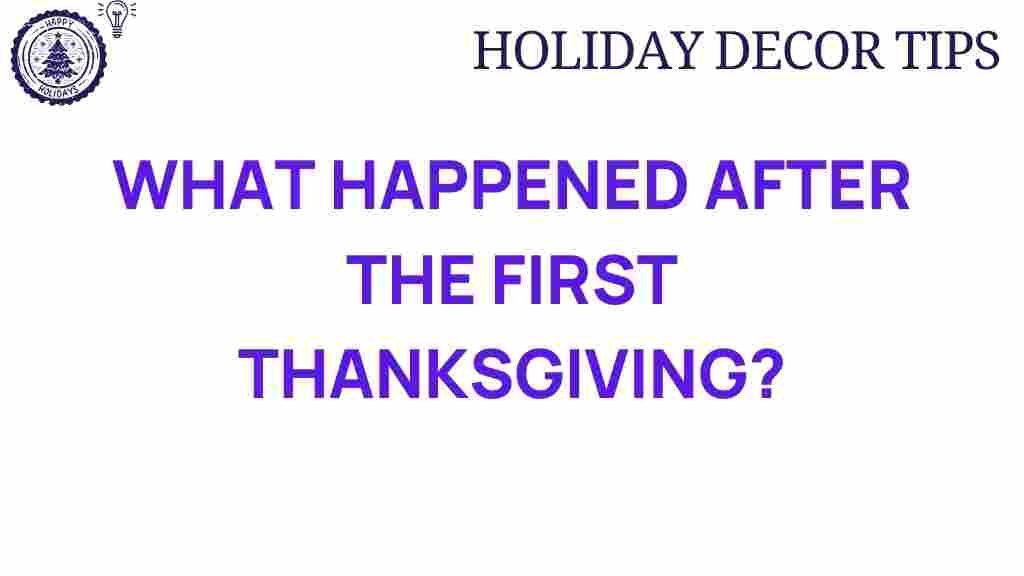Thanksgiving History: Unraveling the Mysteries of What Happened After the First Thanksgiving
Thanksgiving is a cherished holiday in the United States, celebrated with family gatherings, feasting, and expressions of gratitude. While the first Thanksgiving in 1621 is often romanticized, the events that followed it are fraught with complexities and historical significance. In this article, we’ll delve into the Thanksgiving history, exploring what happened after that inaugural feast and how it shaped the relationships between Native Americans and European settlers.
The Setting of the First Thanksgiving
To understand what happened after the first Thanksgiving, we must first set the stage. The first Thanksgiving took place in November 1621, in Plymouth, Massachusetts. Pilgrims, who had settled in the New World, invited the Wampanoag tribe to join in a harvest celebration. This feast lasted for three days and was characterized by a spirit of cooperation and mutual respect.
What Happened Next?
After the first Thanksgiving, the relationship between the Pilgrims and the Wampanoag was initially amicable. However, as more settlers arrived, tensions began to rise. Here’s a step-by-step look at what transpired:
- Expansion of Settlements: As more Europeans arrived, they began to settle on lands that were traditionally inhabited by Native Americans. This expansion led to conflicts over land ownership and usage.
- Trade Relationships: The initial goodwill led to trade exchanges between the two groups. The Pilgrims traded European goods for furs and food, which benefited both parties.
- Population Changes: Diseases brought by the European settlers had a devastating effect on Native American populations, leading to a significant decline in their numbers and weakening their ability to resist encroachment on their lands.
- Growing Tensions: As more settlers moved in, the Wampanoag became increasingly concerned about their diminishing resources. Tensions flared, leading to violent conflicts.
The Pequot War and King Philip’s War
Two significant conflicts arose in the years following the first Thanksgiving, which illustrate the breakdown of relations:
The Pequot War (1636-1638)
This war was one of the earliest and most violent conflicts between Native Americans and European settlers. The Pequot tribe resisted English expansion into their territory, leading to a brutal conflict that resulted in the near destruction of the Pequot people.
King Philip’s War (1675-1676)
Named after Metacomet, the chief of the Wampanoag, this war was a desperate, violent struggle against the encroachment of settlers. The conflict was one of the bloodiest in American history and further decimated Native American populations and their lands.
Shifts in Thanksgiving History
As the relationship between settlers and Native Americans deteriorated, the meaning and nature of Thanksgiving began to shift. Here are some key changes:
- Commercialization: By the 19th century, Thanksgiving began to take on a more commercial aspect, with an emphasis on family gatherings and feasting rather than its historical roots.
- National Holiday: In 1863, President Abraham Lincoln proclaimed Thanksgiving a national holiday, emphasizing gratitude and unity during the Civil War. This proclamation further distanced the holiday from its origins.
Modern Interpretations of Thanksgiving
Today, Thanksgiving is a time for reflection and gratitude, but it also brings discussions surrounding its history. Many people are now more aware of the complex narratives surrounding the holiday, including:
- Indigenous Perspectives: Many Native Americans observe a National Day of Mourning on the same day as Thanksgiving, reflecting on the history of colonization and its impact on their communities.
- Educational Initiatives: Schools and organizations are increasingly focused on teaching a more nuanced history of Thanksgiving, highlighting both the celebrations and the struggles faced by Native Americans.
Thanksgiving Today: A Time for Reflection
While Thanksgiving remains a time for families to come together, it also serves as a reminder of the complexities of American history. Here are some points to consider:
- Gratitude and Acknowledgment: Many families now include discussions about the historical context of Thanksgiving, fostering a sense of gratitude that acknowledges the past.
- Community Involvement: Many communities engage in charitable acts during the Thanksgiving season, such as food drives and community meals, aiming to give back and support those in need.
Troubleshooting Tips for Thanksgiving Gatherings
As you prepare for your Thanksgiving celebration, consider these troubleshooting tips to ensure a smooth event:
- Plan Ahead: Create a checklist to help manage your tasks leading up to the holiday. This can include meal planning, shopping lists, and guest accommodations.
- Communicate: Ensure everyone is on the same page regarding the time and location of the gathering. Open channels of communication can help prevent misunderstandings.
- Be Flexible: Sometimes, things don’t go as planned. Be ready to adapt to unexpected changes, whether it’s a dish that didn’t turn out as expected or a last-minute guest.
- Practice Gratitude: Regardless of the challenges that may arise, take a moment to reflect on what you are thankful for. This mindset can help ease stress and enhance the holiday experience.
Conclusion: Embracing Thanksgiving History
Understanding the Thanksgiving history requires an exploration of both the celebrations and the conflicts that followed the first Thanksgiving. While the holiday remains a time for gratitude and family unity, it’s essential to acknowledge the historical complexities that shaped its evolution. By embracing this richer narrative, we can foster a deeper appreciation for Thanksgiving and its significance in American culture.
As you celebrate this Thanksgiving, consider adding a moment of reflection for the diverse histories that intersect on this holiday. For further insights into Thanksgiving and its evolving narrative, visit this comprehensive guide on Thanksgiving history.
Let’s continue to explore, learn, and celebrate the multifaceted stories that make Thanksgiving a unique and meaningful occasion.
This article is in the category Themes and created by HolidayDecorTips Team
